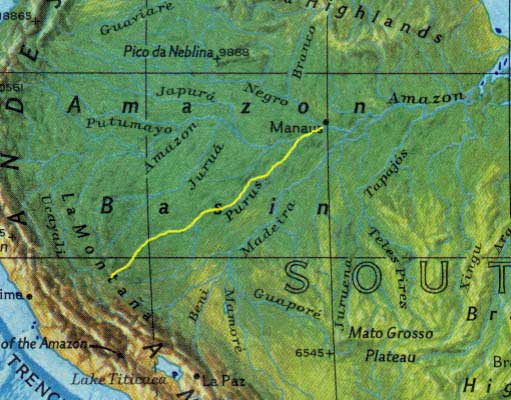Four years after Tatunca Nara was born, Reinha (his mother) returned
to Germany as an ambassador to Hitler's Third Reich. A year later
she returned with three German leaders and negotiated an agreement
with the Ugha Mongulala. The Ugha Mongulala and the Germans would be allies
in a plan that would rule Brazil.
The Nazis would invade Brazil in 1945, occupy the large coastal cities and the Ugha Mongulala would attack the white settlements in the interior. After the expected victory, the Germans would rule the eastern provinces along the coast and the Ugha Mongulala would reclaim the region of the Great (Amazon) River.
According to Tatunca Nara, the first Nazi soldiers reached Akakor by U-boat in 1941; the last soldiers arriving in 1945.
For years the Germans lived with the Ugha Mongulala, arming them and training them for a war that never came. But in 1963 fighting erupted between the Germans and the Ugha Mongulala and Peru. The Germans and the Ugha Mongulala killed a number of white settlers in the Madre Dios region, but when the Peruvian government counter-attacked, the Ugha Mongulala retreated back to Akakor.
In 1968,
a plane crashed near Akakor. Sinkaia ordered his son, Tatunca,
to go to the crash site and kill the survivors, who were being
held captive by another tribe. But instead of slaying the survivors,
Tatunca was able to release them from their captives and led
them to Manaus.
As it turned out, the 12 survivors were officers of the Brazilian
government.
Tatunca
Nara eventually became the new tribal leader of the Ugha Mongulala
and in 1972 he went to Manaus to negotiate with the White Barbarians
in an effort to secure peace with them (he felt it was useless to fight them
any longer.) It was during this trip that he met Karl Brugger,
the German journalist who documented the story you are reading
here.
Karl Brugger
checked out what elements of Tatunca Nara's story he could and
found them to be true. For example, Natunca claimed he saved the lives
of 12 Brazilian officers (whose plane had crashed in the jungle)
by obtaining their release from the Haisha Indians who had held
them captive. He then led them to Manaus, where he originally
met Karl Brugger. According to Brugger, Nara's story has been documented in
the archives of Rio de Janeiro, Brasilia, Manaus, and Rio Branco. Independent newspaper
documentation of the tale is available beginning in 1968, which
mentions "a white Indian chieftain who saved the lives of
12 Brazilian officers by obtaining their release from the Haisha
Indians and leading them to Manaus. Witnesses said he spoke broken
German, a number of Indian languages from the upper Amazon, and
a little Portuguese."
It was during
Tatunca and Karl Brugger's second meeting that Brugger accepted
Tatunca's offer to accompany him up into the dangerous and forbidden
rainforest to see the secret city of Akakor for himself first
hand.
On September 25, 1972, with a Winchester rifle, two revolvers,
machetes, food, hammocks, jungle attire, medicine and other provisions
and equipment, Tatunca Nara, Karl Brugger and a Brazilian photographer
departed Manaus by river and motored up the Rios Purus to the
secret city.

Once they reached the Rio Yaku, their plan was to continue by canoe as far as they could and then proceed on foot through the foothills of the Andes to Akakor. Tatunca estimated that it would take six (6) weeks.